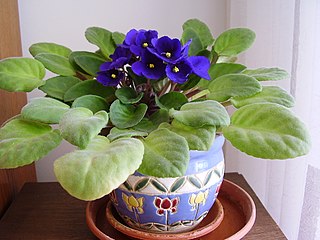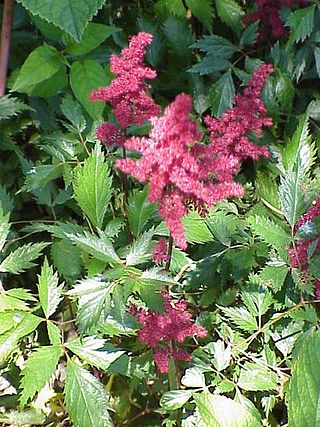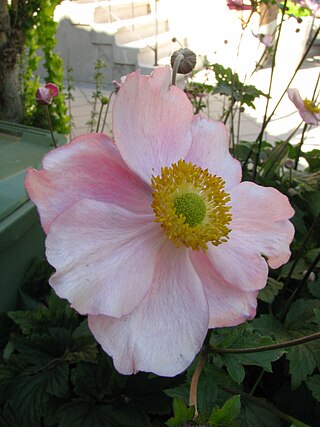
The Royal Horticultural Society (RHS), founded in 1804 as the Horticultural Society of London, is the UK's leading gardening charity.

Gesneriaceae, the gesneriad family, is a family of flowering plants consisting of about 152 genera and ca. 3,540 species in the tropics and subtropics of the Old World and the New World, with a very small number extending to temperate areas. Many species have colorful and showy flowers and are cultivated as ornamental plants.

Lonicera etrusca is a species of honeysuckle known by the common name Etruscan honeysuckle. It is native to Southern Europe, Western Asia and North Africa and it is known elsewhere, including the Pacific Northwest of North America, as an introduced species where it has escaped cultivation. It is kept in gardens as an ornamental plant.

The Award of Garden Merit (AGM) is a long-established annual award for plants by the British Royal Horticultural Society (RHS). It is based on assessment of the plants' performance under UK growing conditions.

Columnea is a genus of around 200 species of epiphytic herbs and shrubs in the family Gesneriaceae, native to the tropics of the Americas and the Caribbean. The tubular or oddly shaped flowers are usually large and brightly colored – usually red, yellow, or orange – sometimes resembling a fish in shape. A common name is flying goldfish plants due to the unusual flower shape.

Astilbe is a genus of 18 species of rhizomatous flowering plants within the family Saxifragaceae, native to mountain ravines and woodlands in Asia and North America. Some species are known by the common names false goat's beard and false spirea.

Bistorta affinis, the Himalayan bistort, fleece flower, or knotweed, is a species of flowering plant in the family Polygonaceae, native to the Himalayas.

Chaenomeles speciosa, the flowering quince, Chinese quince or Japanese quince, is a thorny deciduous or semi-evergreen shrub native to eastern Asia. It is taller than another commonly cultivated species, C. japonica, usually growing to about 2 m. The flowers are usually red, but may be white or pink. The fruit is a fragrant, hard pome that resembles a quince.
Trichodesma microcalyx is a species of plant in the family Boraginaceae. It is endemic to Yemen. Its natural habitats are subtropical or tropical dry forests and subtropical or tropical dry shrubland.

Astilbe chinensis, commonly known as false goat's beard, tall false-buck's-beard or Chinese astilbe, is a plant in the saxifrage family, Saxifragaceae. It is a perennial herb that grows near shaded streams and rivers. It is also commonly grown in shade gardens.

Salvia is the largest genus of plants in the sage family Lamiaceae, with nearly 1000 species of shrubs, herbaceous perennials, and annuals. Within the Lamiaceae, Salvia is part of the tribe Mentheae within the subfamily Nepetoideae. One of several genera commonly referred to as sage, it includes two widely used herbs, Salvia officinalis and Salvia rosmarinus.

Eriocapitella hupehensis, a species of flowering plant in the buttercup family Ranunculaceae, is native to Asia. The specific epithet hupehensis, which means "from Hupeh province, China", refers to a region where the species is known to occur. In Chinese, it is called dǎ pò wǎn huā huā (打破碗花花), which means "broken bowl flower".

Salvia × superba is a widely grown Salvia hybrid. Its origins are unknown, though it first appeared in cultivation, and its parents are believed to include Salvia × sylvestris and Salvia amplexicaulis. Salvia nemorosa has also been suggested as a direct parent or close relative, but with so many similarities between these species and hybrids, there is no conclusive evidence. It is often mistakenly called Salvia superba.

Acer palmatum, commonly known as Japanese maple, palmate maple, or smooth Japanese maple (Japanese: irohamomiji, イロハモミジ, or momiji,, is a species of woody plant native to Japan, Korea, China, eastern Mongolia, and southeast Russia. Many different cultivars of this maple have been selected and they are grown worldwide for their large variety of attractive forms, leaf shapes, and spectacular colors.

Rodgersia pinnata is a species of flowering plant in the family Saxifragaceae, native to the Sichuan and Yunnan provinces of China. It is a robust, herbaceous perennial growing to 120 cm (47 in) tall by 75 cm (30 in) broad, with textured palmate/pinnate leaves up to 90 cm (35 in) long, with 5-9 leaflets. 60 cm (24 in) erect panicles made up of tiny, star-shaped flowers, are borne on reddish green stems in summer. The flowers are white.

Syringa pubescens is a species of flowering plant in the lilac genus of the family Oleaceae, native to Korea and China.

Columnea gloriosa is commonly known as the goldfish plant, because of the fish shaped flowers it produces. It falls into the genus Columnea. Also known as a cousin to African violets. This plant is in the family Gesneriaceae. Some authorities have it as a synonym of Columnea microcalyx. Origins are from Central and South America and the Caribbean.

Betonica macrantha, formerly Stachys macrantha, known as big betony, is a species of flowering plant in the mint family Lamiaceae. It is native to the Caucasus, northeastern Turkey, and northwestern Iran. Growing to 60 cm (24 in) tall by 30 cm (12 in) broad, it is an erect herbaceous perennial with scalloped cordate leaves. Spikes of hooded purplish-pink flowers are borne throughout summer.

Eriocapitella is a genus of flowering plants in the buttercup family Ranunculaceae. Plants of the genus are native to Asia. The generic name Eriocapitella roughly translates to "growing in a small woolly head", which refers to the hairy ovary and fruit of some members of the genus. Cultivated plants are commonly known as fall-blooming anemones.

Eriocapitella × hybrida is a hybrid of flowering plants in the buttercup family Ranunculaceae. The parents of the hybrid are E. japonica and E. vitifolia. Cultivars of the hybrid are commonly known as Japanese anemone hybrids.



















